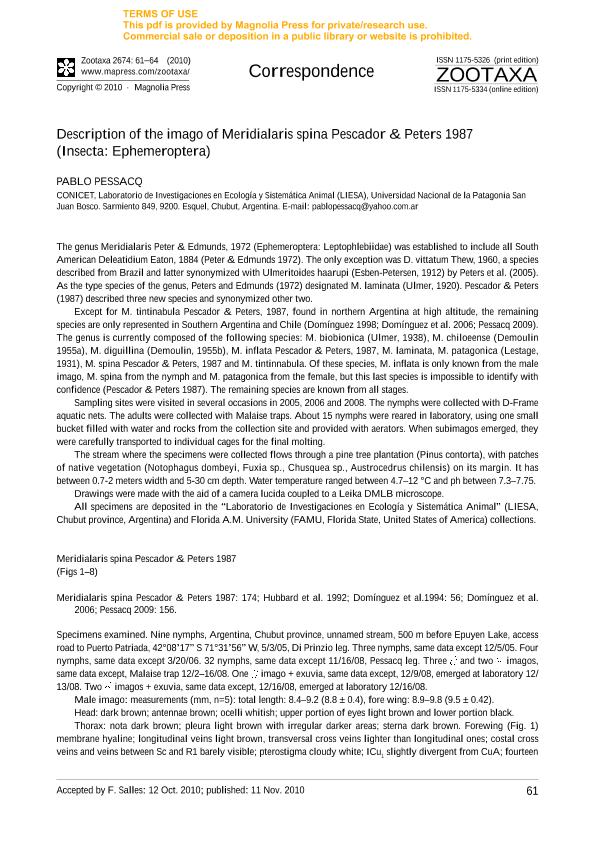Mostrar el registro sencillo del ítem
dc.contributor.author
Pessacq, Pablo

dc.date.available
2023-05-04T11:50:47Z
dc.date.issued
2010-11
dc.identifier.citation
Pessacq, Pablo; Description of the imago of Meridialaris spina Pescador & Peters 1987 (Insecta: Ephemeroptera); Magnolia Press; Zootaxa; 2674; 11-2010; 61-64
dc.identifier.issn
1175-5326
dc.identifier.uri
http://hdl.handle.net/11336/196233
dc.description.abstract
The genus Meridialaris Peter & Edmunds, 1972 (Ephemeroptera: Leptophlebiidae) was established to include all South American Deleatidium Eaton, 1884 (Peter & Edmunds 1972). The only exception was D. vittatum Thew, 1960, a species described from Brazil and latter synonymized with Ulmeritoides haarupi (Esben-Petersen, 1912) by Peters et al. (2005). As the type species of the genus, Peters and Edmunds (1972) designated M. laminata (Ulmer, 1920). Pescador & Peters (1987) described three new species and synonymized other two.Except for M. tintinabula Pescador & Peters, 1987, found in northern Argentina at high altitude, the remaining species are only represented in Southern Argentina and Chile (Domínguez 1998; Domínguez et al. 2006; Pessacq 2009). The genus is currently composed of the following species: M. biobionica (Ulmer, 1938), M. chiloeense (Demoulin 1955a), M. diguillina (Demoulin, 1955b), M. inflata Pescador & Peters, 1987, M. laminata, M. patagonica (Lestage, 1931), M. spina Pescador & Peters, 1987 and M. tintinnabula. Of these species, M. inflata is only known from the male imago, M. spina from the nymph and M. patagonica from the female, but this last species is impossible to identify with confidence (Pescador & Peters 1987). The remaining species are known from all stages.Sampling sites were visited in several occasions in 2005, 2006 and 2008. The nymphs were collected with D-Frame aquatic nets. The adults were collected with Malaise traps. About 15 nymphs were reared in laboratory, using one small bucket filled with water and rocks from the collection site and provided with aerators. When subimagos emerged, they were carefully transported to individual cages for the final molting.The stream where the specimens were collected flows through a pine tree plantation (Pinus contorta), with patches of native vegetation (Notophagus dombeyi, Fuxia sp., Chusquea sp., Austrocedrus chilensis) on its margin. It has between 0.7-2 meters width and 5-30 cm depth. Water temperature ranged between 4.7–12 °C and ph between 7.3–7.75.Drawings were made with the aid of a camera lucida coupled to a Leika DMLB microscope.All specimens are deposited in the “Laboratorio de Investigaciones en Ecología y Sistemática Animal” (LIESA, Chubut province, Argentina) and Florida A.M. University (FAMU, Florida State, United States of America) collections.
dc.format
application/pdf
dc.language.iso
eng
dc.publisher
Magnolia Press

dc.rights
info:eu-repo/semantics/openAccess
dc.rights.uri
https://creativecommons.org/licenses/by-nc-sa/2.5/ar/
dc.subject
Sin palabras clave
dc.subject.classification
Zoología, Ornitología, Entomología, Etología

dc.subject.classification
Ciencias Biológicas

dc.subject.classification
CIENCIAS NATURALES Y EXACTAS

dc.title
Description of the imago of Meridialaris spina Pescador & Peters 1987 (Insecta: Ephemeroptera)
dc.type
info:eu-repo/semantics/article
dc.type
info:ar-repo/semantics/artículo
dc.type
info:eu-repo/semantics/publishedVersion
dc.date.updated
2023-05-03T13:25:34Z
dc.journal.volume
2674
dc.journal.pagination
61-64
dc.journal.pais
Nueva Zelanda

dc.description.fil
Fil: Pessacq, Pablo. Universidad Nacional de la Patagonia "San Juan Bosco". Facultad de Ciencias Naturales - Sede Esquel. Departamento de Biología. Laboratorio de Investigaciones en Ecología y Sistemática Animal; Argentina. Consejo Nacional de Investigaciones Científicas y Técnicas; Argentina
dc.journal.title
Zootaxa

dc.relation.alternativeid
info:eu-repo/semantics/altIdentifier/url/https://www.mapress.com/zt/article/view/zootaxa.2674.1.5
Archivos asociados
